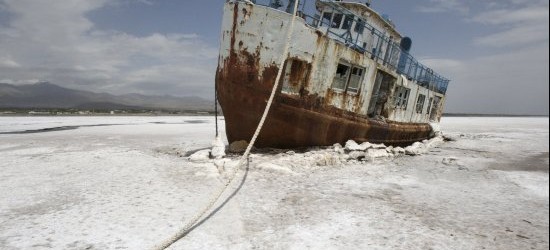
The long popular lake, home to migrating flamingos, pelicans and gulls, has shrunken by 60 percent and could disappear entirely in just a few years, experts say — drained by drought, misguided irrigation policies, development and the damming of rivers that feed it.
In April, authorities stopped activities at the nearby jetty in Golmankhaneh harbor, due to lack of water in the lake, now only two meters deep at its deepest. Jetties in Sharafkhaneh and Eslami harbors faced the same fate. The receding water has also weakened hotel business and tourism activities in the area, and planned hotel projects remain idle since investors are reluctant to continue.
Beyond tourism, the salt-saturated lake threatens agriculture nearby in northwest Iran, as storms sometimes carry the salt far afield. Many farmers worry about the future of their lands, which for centuries have been famous for apples, grapes, walnuts, almonds, onions, potatoes, as well as aromatic herbal drinks, candies and tasty sweet pastes.
“The salty winds not only will affect surrounding areas but also can damage farming in remote areas,” said Masoud Mohammadian, an agriculture official in the eastern part of the lake, some 370 miles (600 kilometers) northwest of the capital Tehran.
Other officials echoed the dire forecast. Salman Zaker, a parliament member for Oroumieh warned last month that, “with the current trend, the risk of a salt tsunami is increasing.” Warning that the lake would dry out within three to five years — an assessment agreed to by the local environment department director, Hasan Abbasnejad — Zaker said eight to 10 billion tons of salt would jeopardize life for millions of people.
How did this disaster develop, and what can be done now?
Official reports blame the drying mainly on a decade-long drought, and peripherally on consumption of water of the feeding rivers for farming. They put 5 percent of the blame on construction of dams and 3 percent on other factors. Others disagree about the relative blame.
The first alarm over the lake’s shrinking came in late 1990s amid a nagging drought. Nonetheless, the government continued construction of 35 dams on the rivers which feed the lake; 10 more dams are on the drawing boards for the next few years.
Also completed was a lake-crossing roadway between Oroumieh and Tabriz, cities on the west and east of the lake. No environmental feasibility study was done in the planning for the road, and environmentalists believe the project worsened the lake’s health by acting as a barrier to water circulation.
In the early 2000s, academic research concluded that the lake could face the same destiny as the Aral Sea in Kazakhstan and Uzbekistan, which has been steadily shrinking since rivers that feed it were diverted by Soviet Union irrigation projects in 1960s. It is now less than one-tenth of its original size.
In April, the Iranian government announced a three-prong effort to save the lake: a cloud-seeding program to increase rainfall in the area, a lowering of water consumption by irrigation systems, and supplying the lake with remote sources of water.
Read More: thewatchers.adorraeli.com
